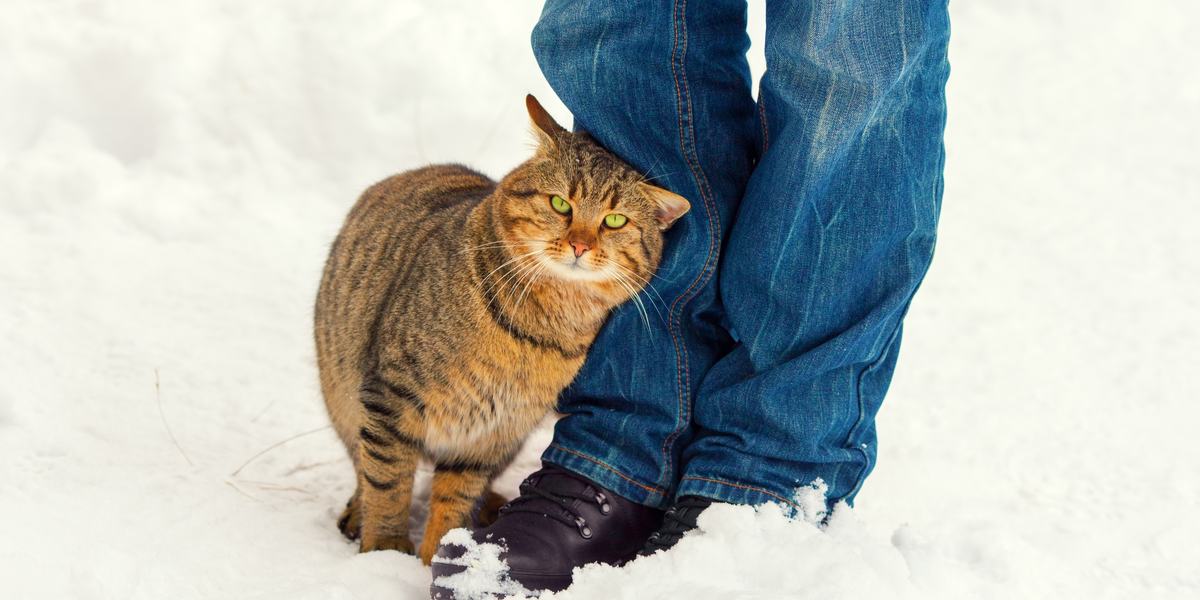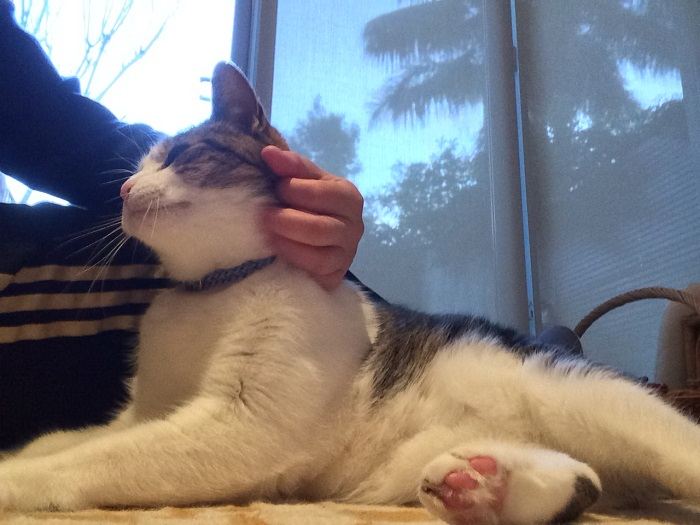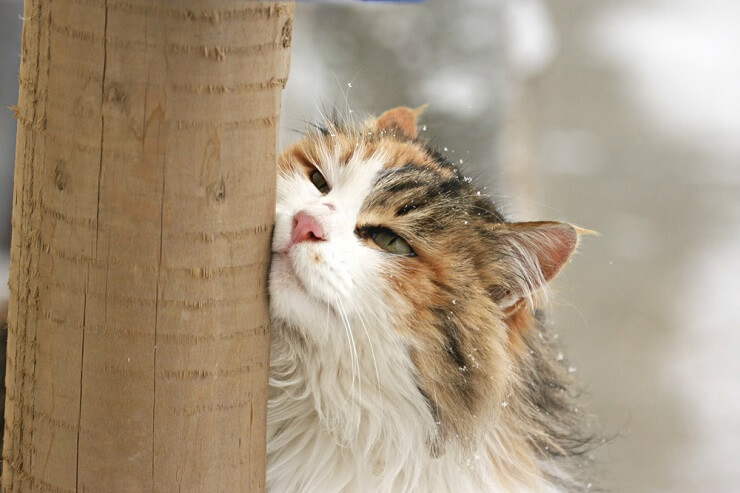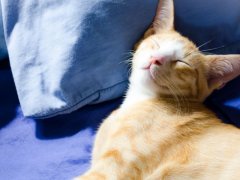
I love when my cat Simba rubs against my leg once I return home from work or when I open his favorite canned food. There’s always the added bonus when he bunts his head against mine in a show of affection.
Felines convey how they feel through their behavior and body language, but properly understanding what a cat is trying to express through tactile and olfactory communication can be a little tricky.
Cats love caressing their fluffy bodies against people, other pets, and even objects. Although it may seem peculiar, there’s an important purpose to this behavior, and we are going to delve into the science behind it.
Why Do Cats Rub Against People?
Let’s closely examine reasons why cats rub against their owners and the meaning of this gratifying behaviour.
Pheromone Deposit and Intermingling of Chemical Messages
Cats have scent glands that release pheromones from many parts of their bodies, including the cheek glands, and around the mouth, forehead, base of the tail, paw pads, and anal region.
When a cat scrapes or bunts their owner, the cat deposits a chemical message that transfers information about their current emotional state and sexual receptivity, and also specifies their territory.
Familiarity, Acceptance, and Positive Emotion
When a cat rubs against an individual, it usually displays pleasurable positive emotions and is a sign of affection during cat-human interactions. A feline nuzzling against their companion to mark their scent indicates familiarity and a sense of security, including acceptance.
Attention-Seeking Behavior

Stormy rubbing against my leg. Melina Grin / Cats.com
A cat will solicit attention by weaving through an owner’s legs, intertwining their tail and even head-butting them. This may occur while the owner is preparing food or when the cat wants affection or outdoor access.
Some cats may become frustrated when attention-seeking behavior doesn’t lead to expected outcomes, so take care to not reinforce solicitation behavior, which can become a problem behavior in the future.
Greeting Behavior
Most owners are flattered when their kitty rubs their head or body against them when they come home. Many cats will meow, social roll, and rub against their caregiver, communicating welcoming intent, which is often aimed toward humans the cat has a positive relationship with.
In fact, allorubbing is a vital greeting behavior for felines, something that is highlighted by a 2021 study in which 83% of cats rubbed against their owner when they were united after a separation.
Pleasurable Experience for Your Cat
When a cat rubs against a person with their cheeks, head, or side of the body and/or tail, or gets stroked by a person in a way that the cat likes, it produces a pleasurable, rewarding experience that supports homeostatic balance in the feline brain.
Cat Pregnancy Stage of Pre-Birth
A pregnant queen in the pre-birth stage will become either less or more sociable to people and other pets within the household, depending on her individual personality. Certain queens have been seen to seek more owner attention by purring and rubbing around the owner’s leg’s more frequently, including displayed increased allorubbing alongside other cats and household pets.
Why Do Cats Rub Against Each Other and Other Pets?
Allorubbing Against Same Species
Body rubbing entails shifting one side of the cat’s body along another individual’s body by creating physical contact. Cats display allorubbing toward other cats with which they have affiliative relationship. The behavior helps them maintain the group’s odor through scent exchange. Brushing and grooming against each other indicates that the cats are part of the same social group.
Allo-Body Rubbing and Head Butting of Other Pets
Since cats have scent glands all over their bodies, allorubbing can be accompanied by head butting, which may be followed by tail wrapping against other pets. Allo-body rubbing is usually reserved toward familiar household animals, and is a sign that your cat is bonded with your pet and considers it part of their common group.
Why Do Cats Rub Against Objects?

Territorial Marking
It’s believed that object marking, urine spraying, and middening (deposition of unburied faeces in unusual locations) is used to communicate territoriality over a physical area.
When a cat rubs/marks an object, it leaves a unique scent. Since territorial marking is more aimed toward specific areas and objects, cats that have outdoor access should be provided the ability to object mark planters, logs, and garden furniture to enable them to defend their territory by leaving visual and scent marks from their paw glands.
Head Bunting and Facial Rubbing

Biz facial rubbing. Melina Grin / Cats.com
Head bunting or head butting consists of a feline rubbing its head region on another cat, human or prominent object within the home while facial rubbing is often achieved by using the cat’s cheeks, chin, and lips.
The bunting activity usually takes place in the cat’s core territory and is most likely associated with reassurance, comfort, and friendly social interactions. Facial rubbing on fixtures and door frames is associated with territorial and sexual behavior.
Courtship and Mating Behaviour
During proestrus and estrus (behavioral receptiveness to mating), females will perform courtship behaviors in order to attract a male. Behavioural signs of proestrus and estrus are subtle, and consist of rolling, kneading, enhanced vocalization, and increased object rubbing.
It’s hypothesized that rub-marks of a queen may contain data about the stage of the estrus cycle she is in. Males also use object rubbing through deposit of facial pheromones to demonstrate courtship toward females in estrus.
Should You Be Concerned if Your Cat Rubs Against You or Objects All of the Time?

If your cat suddenly starts rubbing against you or against objects incessantly while displaying odd behavioral changes, it may require a veterinary examination to rule out any illness or distress.
Frustration when attention-seeking behavior isn’t reciprocated by a caregiver also can evoke excessive rubbing, licking, and biting. Most likely your cat will also meow persistently and loudly, and attempt to swipe you to draw in your attention.
If your cat is facial rubbing against your hand and inviting you to stroke their favorite body parts like their head and face, but instead you select to rub their tummy, it may induce both seeking as well as frustration emotions at the denial of interaction of the desired body part. Your cat may display this frustration through a swift groom on their shoulder or a body shake.
Lastly, if you don’t like when your cat repeatedly facial rubs corners of walls, furniture, or door frames (since it leaves a brown oily residue), there are commercially available devices to encourage your cat to facial rub on them, for instance the Catit Senses 2.0 Wellness Centre as seen in this video and the Catit Senses 2.0 Self Groomer.
Conclusion
Cats rely on communication production of scent pheromones, like those deposited during facial rubbing, bunting, scratching, and urine-marking, which contain beneficial information coded in these messages.
Please enjoy all the stroking and head-butting, however, watch out for subtle shifts in your cat’s body language that may indicate changes in their emotions and intentions.
Frequently Asked Questions
How do you know if a cat likes you?
If a cat likes you, they will want to spend a lot of time with you, they will look forward to you returning home, and display fondness through head-butts, rubbing, purring, rolling on the floor, kneading, and through slow blinking.
What does a cat mean when he rubs against your legs?
When a cat rubs against your legs or against an item, it leaves a chemical message to declare ownership, and territoriality. Rubbing against an owner or caregiver likewise indicates relaxation, affection, and willingness to interact with the person.
What does it mean when a cat rubs against your leg and purrs?
When a cat rubs against your leg and purrs, it indicates friendly behavior, which communicates close social bond. The cat considers you part of their social group, and offers you love and acceptance, so please enjoy the attention from your feline companion.
-
Care, I. C. (2020, September 01). Advanced Feline Behaviour for Vet Professionals Module 2 Senses and communication. UK. Retrieved April 01, 2022
-
Care, I. C. (2020, Septmeber 15). Advanced Feline Behaviour for Vet Professionals, Module 4 What do I feel and am I Ok? (ISFM, Compiler) UK. Retrieved April 04, 2022
-
Care, I. C. (2020, September 01). Module 3 Reproduction, Behavioural Development and Behavioural Health in Kittens. Advanced Feline Behaviour for Vet Professionals. UK. Retrieved April 02, 2022
-
Heath, I. R. (2016). Feline Behavioral Health and Welfare. St Louis, MO: Elsevier. Retrieved March 31, 2022
-
iCatCare. (2018, October 05). Cat Communication. Retrieved March 30, 2022, from International Cat Care: https://icatcare.org/advice/cat-communication/
-
Sparkes, D. S. (2016). ISFM Guide to Feline Stress and Health; Managing negative emotions to improve feline health and wellbeing. Tisbury, Wiltshire, UK: International Cat Care. Retrieved March 29, 2022
-
Behnke, A. C., Vitale, K. R., & Udell, M. A. (2021). The effect of owner presence and scent on stress resilience in cats. Applied Animal Behaviour Science, 243, 105444. https://doi.org/10.1016/j.applanim.2021.105444







